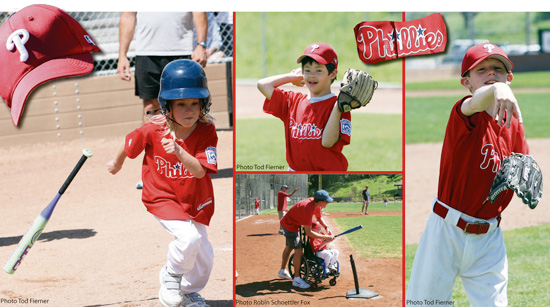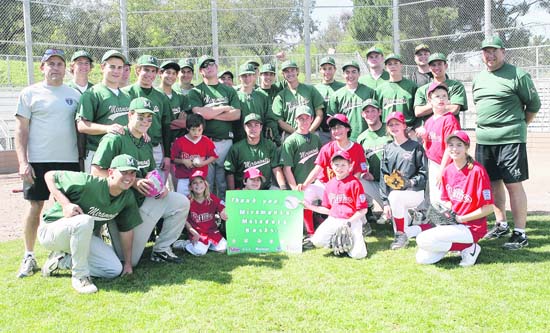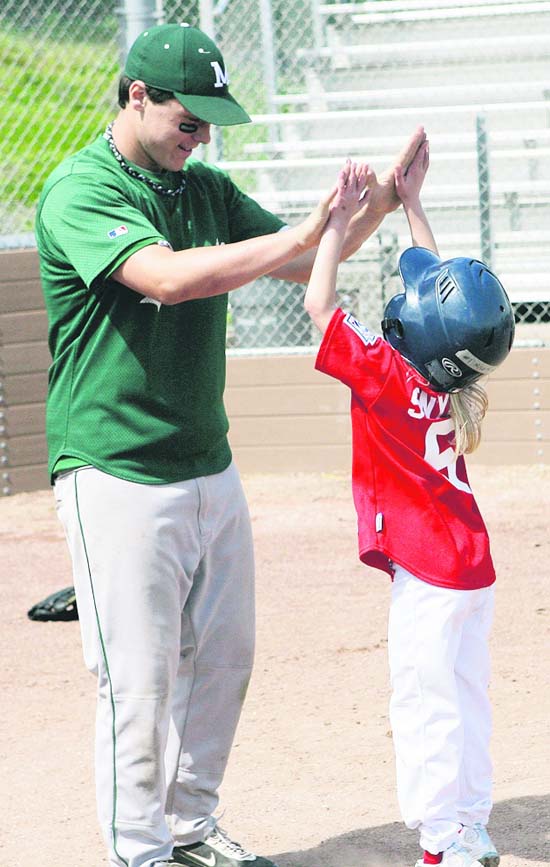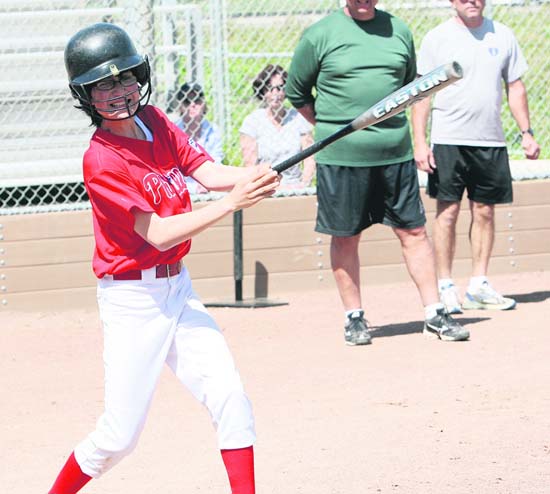|
|
Published April 29th, 2009
|
A Field of Opportunity
|
| By Robin Schoettler Fox |
 |
| Photos Tod Fierner and Robin Schoettler Fox
|
Imagine a baseball game where everyone wins.
 Welcome to Little League's Challenger Division. Nationally sanctioned since 1989 and part of Lafayette Little League (LLL) since 2007, Challenger is designed for players with special needs, ages six through high school. Locally, games are played Sundays at 2 p.m., often at Lafayette's Buckeye Fields.
Welcome to Little League's Challenger Division. Nationally sanctioned since 1989 and part of Lafayette Little League (LLL) since 2007, Challenger is designed for players with special needs, ages six through high school. Locally, games are played Sundays at 2 p.m., often at Lafayette's Buckeye Fields.
 In Challenger games, wins aren't measured in runs scored. "Outs" might earn high-fives but don't always send runners to the dugout. "Three strikes" mean a player could use a few extra pitches. Help chasing a ball? That's what parents and "Buddies" like Challenger volunteers Eric Sondel, Taylor Ewing and Evan Heptig, all current Acalanes sophomores, are for.
In Challenger games, wins aren't measured in runs scored. "Outs" might earn high-fives but don't always send runners to the dugout. "Three strikes" mean a player could use a few extra pitches. Help chasing a ball? That's what parents and "Buddies" like Challenger volunteers Eric Sondel, Taylor Ewing and Evan Heptig, all current Acalanes sophomores, are for.
 Heptig, a former Little Leaguer who now plays for Acalanes, says it's great to work with players who love the game; that the kids seem "just happy to be able to play, to come out each day."
Heptig, a former Little Leaguer who now plays for Acalanes, says it's great to work with players who love the game; that the kids seem "just happy to be able to play, to come out each day."
 The Challenger program offers a field of play where, "The kids can just be themselves and not worry about striking out or making the third out with bases loaded, or giving up a big hit, disappointing their team members," says Rosemary Kirbach, the player-parent who organized Lafayette's Challenger program with help from Adam Henderson, who was then League VP - AAA Division.
The Challenger program offers a field of play where, "The kids can just be themselves and not worry about striking out or making the third out with bases loaded, or giving up a big hit, disappointing their team members," says Rosemary Kirbach, the player-parent who organized Lafayette's Challenger program with help from Adam Henderson, who was then League VP - AAA Division.
 Kirbach, whose son Patrick is still on the team, currently serves on the LLL Board as League VP-Challenger Division.
Kirbach, whose son Patrick is still on the team, currently serves on the LLL Board as League VP-Challenger Division.
 In Challenger games, flexibility rules -- but baseball fundamentals stay true. Kids hit, throw and run bases. Uniformed players compete as teams on standard Little League fields, playing other area Challenger teams. The flexible rules help level the field so players across a broad spectrum of ages, as well as physical or educational challenges, can play and have fun together.
In Challenger games, flexibility rules -- but baseball fundamentals stay true. Kids hit, throw and run bases. Uniformed players compete as teams on standard Little League fields, playing other area Challenger teams. The flexible rules help level the field so players across a broad spectrum of ages, as well as physical or educational challenges, can play and have fun together.
 Having fun is the key, says Challenger player mom Crystal Lee, "but at the same time (the players) can learn." It's that combination, she says, that helped her son, Stanley 7th-grader Andrew Hissen, move from timid at the plate three seasons ago to this year's enthusiastic big-hitter. It's a skill that makes Andrew smile. "I love hitting home runs," he says.
Having fun is the key, says Challenger player mom Crystal Lee, "but at the same time (the players) can learn." It's that combination, she says, that helped her son, Stanley 7th-grader Andrew Hissen, move from timid at the plate three seasons ago to this year's enthusiastic big-hitter. It's a skill that makes Andrew smile. "I love hitting home runs," he says.
 Lafayette's 2009 Challenger "Phillies" is a 17-player team ranging in age from 6 to 15, and includes players from Moraga and a student at Orinda's Wagner Ranch. A third of the players are girls.
Lafayette's 2009 Challenger "Phillies" is a 17-player team ranging in age from 6 to 15, and includes players from Moraga and a student at Orinda's Wagner Ranch. A third of the players are girls.
 Seventeen is a big jump from the 6 players who took to the field back in Spring 2007, for the first-ever Lafayette Challenger opening day, a team hastily formed by Kirbach when those first year District approvals cleared after the usual Little League sign-up window closed. After the first game with the Concord Challenger team, though, word of mouth quickly filled the roster. By season's end, there was a waiting list.
Seventeen is a big jump from the 6 players who took to the field back in Spring 2007, for the first-ever Lafayette Challenger opening day, a team hastily formed by Kirbach when those first year District approvals cleared after the usual Little League sign-up window closed. After the first game with the Concord Challenger team, though, word of mouth quickly filled the roster. By season's end, there was a waiting list.
 The Lafayette Challenger team runs on a volunteer engine that starts with family commitment and quickly extends beyond adult volunteers and even high school youth, to tap an increasing number of Little League players. The community at large, says Kirbach, has been "phenomenal in terms of embracing and supporting this team" not just financially but also with "baseball knowledge and time."
The Lafayette Challenger team runs on a volunteer engine that starts with family commitment and quickly extends beyond adult volunteers and even high school youth, to tap an increasing number of Little League players. The community at large, says Kirbach, has been "phenomenal in terms of embracing and supporting this team" not just financially but also with "baseball knowledge and time."
 And the team is open to new ways to expand community involvement. Recently, Miramonte senior Joey Epperson organized a scrimmage between Miramonte varsity and Challenger players on the Matadors' home field. The two teams reshuffled rosters and played side by side, creating a sandlot-style game where Challenger players geared up to play on a bigger field and the varsity players dialed their play to "just for fun." It was an experience Epperson described afterwards as having offered perspective for a close-knit varsity team still frustrated by a recent loss to Campo. And it served as a reminder: "We all love this game," he said.
And the team is open to new ways to expand community involvement. Recently, Miramonte senior Joey Epperson organized a scrimmage between Miramonte varsity and Challenger players on the Matadors' home field. The two teams reshuffled rosters and played side by side, creating a sandlot-style game where Challenger players geared up to play on a bigger field and the varsity players dialed their play to "just for fun." It was an experience Epperson described afterwards as having offered perspective for a close-knit varsity team still frustrated by a recent loss to Campo. And it served as a reminder: "We all love this game," he said.
 The number one question prospective Challenger player families ask Kirbach is, do integration opportunities with the rest of Little League exist? And they do, she says, starting with the team's Monday afternoon practices.
The number one question prospective Challenger player families ask Kirbach is, do integration opportunities with the rest of Little League exist? And they do, she says, starting with the team's Monday afternoon practices.
 That first Challenger season, Henderson designed the four skill-station Monday practice template - fielding, pitching, pitched-ball hitting and soft toss - that remains today. That season, Henderson recruited community and Little League volunteers, including his wife and four sons. This season those Monday skill stations are manned on a rotating basis by Little League AAA and Majors teams, two teams per practice, usually one from each division, coaches and managers included.
That first Challenger season, Henderson designed the four skill-station Monday practice template - fielding, pitching, pitched-ball hitting and soft toss - that remains today. That season, Henderson recruited community and Little League volunteers, including his wife and four sons. This season those Monday skill stations are manned on a rotating basis by Little League AAA and Majors teams, two teams per practice, usually one from each division, coaches and managers included.
 Kirbach calls it "high quality instruction," but it's more than that.
Kirbach calls it "high quality instruction," but it's more than that.
 "It's baseball and there is a common bond for all," says Henderson.
"It's baseball and there is a common bond for all," says Henderson.
 Player peers working together. Fun that fosters learning. Lessons kids take home.
Player peers working together. Fun that fosters learning. Lessons kids take home.
 "They could really hit the ball hard," 10-year-old Majors player Ryan Levy said after his turn manning a skill station, remembering in particular Hissen and how much fun he seemed to be having just hitting the ball and rounding bases.
"They could really hit the ball hard," 10-year-old Majors player Ryan Levy said after his turn manning a skill station, remembering in particular Hissen and how much fun he seemed to be having just hitting the ball and rounding bases.
 On the Challenger field, runs scored might not determine game wins, but they do count. The Challenger team is participating in the league-wide ALS awareness program. Those runs get multiplied by pledges and become donations for the "Runs for ALS" fundraiser.
On the Challenger field, runs scored might not determine game wins, but they do count. The Challenger team is participating in the league-wide ALS awareness program. Those runs get multiplied by pledges and become donations for the "Runs for ALS" fundraiser.
 "We want to support others," says Kirbach. "We're not just about kids with special needs."
"We want to support others," says Kirbach. "We're not just about kids with special needs."

|

Players pause for a post-scrimmage team shot, a momento of a fun afternoon for all on Miramonte's varsity field Photo Tod Fierner
 |
| Players double high-five at the Miramonte-Challenger scrimmage
Photo Tod Fierner
|
 |
| Andrew Hissen goes for another homerun Photo Tod Fierner
|
|
|
|
|
Advertisement
|
|
|
|
|
|
|
|
|
Comments |
|
|
|
|
|
|
|
|
|
|
|
|
|
|
Subscribe / Unsubscribe |
|
|
| |

